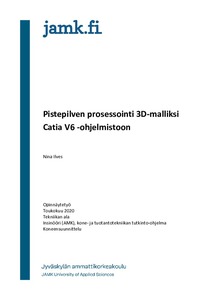Pistepilven prosessointi 3D-malliksi Catia V6 -ohjelmistoon
Ilves, Nina (2020)
Ilves, Nina
2020
All rights reserved. This publication is copyrighted. You may download, display and print it for Your own personal use. Commercial use is prohibited.
Julkaisun pysyvä osoite on
https://urn.fi/URN:NBN:fi:amk-2020060316678
https://urn.fi/URN:NBN:fi:amk-2020060316678
Tiivistelmä
Laserkeilaus on mittausmenetelmä, joka mittaa kohteita koskematta niihin. Mitatut pisteet muodostavat pistepilven, jossa jokaisella pisteellä on koordinaattiarvo. Pistepilviä voidaan käyttää suunnittelussa ja niistä voidaan muodostaa 3D-malleja. Opinnäytetyön tavoitteena oli luoda toimeksiantajalle toimiva prosessi pistepilven käsittelyyn, jonka seurauksena pistepilvi saadaan Catia V6 -ohjelmistoon tiedostomuotoon, jota suunnittelu voi hyödyntää sellaisenaan. Suunnittelutoimisto Hotanen Oy on erikoistunut prosessitekniikan ilmalaitteiden suunnitteluun. Tarkoituksena oli hyödyntää pistepilviä erityisesti kanavistosuunnittelussa. Toimeksiantajalla oli käytössään 3D-skanneri, muttei tarvittavaa ohjelmistoa tai resursseja sen hyödyntämiseen.
Opinnäytetyössä kerättiin tietoa pistepilven käsittelystä haastattelemalla käsittelyohjelmien toimittajia ja tutustumalla toimittajien materiaaleihin. Pistepilven käsittelyohjelmien ominaisuuksia vertailtiin keskenään ja käsittelyohjelmia testattiin.
Tuloksena pistepilvi saatiin käsiteltyä mesh-malliksi, joka saatiin tuotua Catia V6 -ohjelmistoon. Catia V6:lla voidaan tunnistaa piirteitä ja luoda pintamalleja mesh-malleista. Pintamalleja ja mesh-malleja voidaan hyödyntää suunnittelussa erityisesti törmäystarkasteluissa ja uusien osien sovittamisessa vanhaan ympäristöön. Luodut pintamallit voidaan muuntaa solid-malleiksi, jolloin niihin voidaan lisätä 3D-mallien piirteitä, kuten reikiä ja aukkoja.
Opinnäytetyön tulokset eivät ole täysin vertailukelpoisia työelämän laserkeilausprojekteihin, sillä opinnäytetyössä käsitelty pistepilvi oli erittäin pieni. Opinnäytetyön ulkopuolelle jätettiin myös pistepilvien säilyttäminen projektien aikana sekä pitkäaikainen säilyttäminen. Laser scanning is a measuring method that measures objects without touching them. Measured points form a point cloud where every point has a coordinate. Point clouds can be used in engineering and 3D -models can be created from point clouds. The target of the thesis was to create a functional process for point cloud processing. As a result, point cloud is obtained in a file format in Catia V6 software for the design to utilize as it is. Suunnittelutoimisto Hotanen Oy is an engineering office specialized in designing air systems for the process industry. The intention was to utilize point clouds especially in ductwork designing. The assignor had a 3D scanner but no necessary software or resources to utilize it.
In the thesis, information about the point cloud processing software was collected by interviewing software suppliers and familiarizing with the material from software suppliers. The properties of the point cloud processing software were compared, and the software were tested.
As a result, the point cloud was processed into a mesh model which was imported into Catia V6 software. The features can be identified and surface models can be created from mesh models in Catia V6. The surface models and mesh models can be utilized in the design in particular in collision detection and the allocation of new parts in the existing environment. The created surface models can be converted into solid models so that 3D modelling features, such as holes and openings, can be added to them.
The results of the thesis are not completely comparable to the working life laser scanning projects, because the point cloud that was processed in the thesis was extremely small. The thesis also excluded point cloud storage during projects and long-term storage.
Opinnäytetyössä kerättiin tietoa pistepilven käsittelystä haastattelemalla käsittelyohjelmien toimittajia ja tutustumalla toimittajien materiaaleihin. Pistepilven käsittelyohjelmien ominaisuuksia vertailtiin keskenään ja käsittelyohjelmia testattiin.
Tuloksena pistepilvi saatiin käsiteltyä mesh-malliksi, joka saatiin tuotua Catia V6 -ohjelmistoon. Catia V6:lla voidaan tunnistaa piirteitä ja luoda pintamalleja mesh-malleista. Pintamalleja ja mesh-malleja voidaan hyödyntää suunnittelussa erityisesti törmäystarkasteluissa ja uusien osien sovittamisessa vanhaan ympäristöön. Luodut pintamallit voidaan muuntaa solid-malleiksi, jolloin niihin voidaan lisätä 3D-mallien piirteitä, kuten reikiä ja aukkoja.
Opinnäytetyön tulokset eivät ole täysin vertailukelpoisia työelämän laserkeilausprojekteihin, sillä opinnäytetyössä käsitelty pistepilvi oli erittäin pieni. Opinnäytetyön ulkopuolelle jätettiin myös pistepilvien säilyttäminen projektien aikana sekä pitkäaikainen säilyttäminen.
In the thesis, information about the point cloud processing software was collected by interviewing software suppliers and familiarizing with the material from software suppliers. The properties of the point cloud processing software were compared, and the software were tested.
As a result, the point cloud was processed into a mesh model which was imported into Catia V6 software. The features can be identified and surface models can be created from mesh models in Catia V6. The surface models and mesh models can be utilized in the design in particular in collision detection and the allocation of new parts in the existing environment. The created surface models can be converted into solid models so that 3D modelling features, such as holes and openings, can be added to them.
The results of the thesis are not completely comparable to the working life laser scanning projects, because the point cloud that was processed in the thesis was extremely small. The thesis also excluded point cloud storage during projects and long-term storage.
